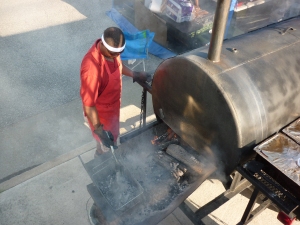Six years ago, when I first started work on the essays that would become Confederate Streets, I spent a lot of time in the Civil Rights Room in the downtown branch of the Nashville Public Library. I didn’t know exactly what I was looking for, only that I had finished an analytical essay on busing for racial balance and that I wanted to, perhaps, write some narrative essays on the same topic. I was also interested in the outdoors and the Cumberland Plateau (subject matter I am pursuing now), and the room next to the Civil Rights Room was full of books on that topic, so I filled a few blistering summer days by wandering back and forth between those cool and pleasant rooms, reading about the sit-ins in one and Beersheba Springs in the other.
The Civil Rights Room is decorated with iconic photos from the movement in Nashville. I spent some time examining each one, but one photo in particular captivated me. You can see it at this link – it is the one at the top of the page. See the woman standing between the children and the crowd as she walks them to their first day of first grade? The girls holding hands? The white children lining the streets, barefoot, perhaps because they were being held out of school that day? I studied each face, each posture, wondered what everyone in that photograph must have been thinking at that moment – a late summer morning, September 9, 1957, the first day that blacks attended Nashville schools which were previously closed to them. However, the reason this picture really, really resonated with me is that exclamation point floating above the crowd – the sign which reads “GOD is the author of segregation.” I was born in the late 1970s and always thought of God as the author of the civil rights movement, of peace, of loving your enemies and praying for those who persecute you. The idea that someone would invoke the name of God as they harassed a couple of six-year-olds on their first day was school was both repulsive and darkly fascinating. Who was that person?
In another photograph, this sign shows up again and the woman holding it is visible, though the children are not. Her face is contorted. She is waving the sign and shouting.
One evening in the summer of 2005, I told one of my friends in Nashville about the picture and she said, “It makes me wonder what that woman must think now when she sees herself in that picture.” I’d been obsessing over every detail the photograph, but I had been thinking of it as something buried in the past, something encapsulated in the 1950s. Leila’s observation changed my perspective. I started wondering, “Where are we now because of where we were then?”
When I returned to Morgantown for the school year and started writing, I remembered those photographs as one in the same. As I wrote what would become the title essay of my collection, I pictured that woman shouting, the children mustering up an awful lot of resolve for six-year-olds, that sign invoking God and waving above it all. I devote about a page in the book to wondering where the woman with that awful sign might be today. I imagine that the sign is long gone, burned. Or, perhaps, it’s waiting in a closet, waiting to be used again. I imagine that the woman who held the sign is either completely mortified or silent and angry whenever she sees children of all races going to school together.
One thing I never did was actually try to find that woman, or the girls being walked to school, or anyone else in the photograph. I merely wondered where their lives had taken them since the morning of September 9, 1957.
Apparently, author David Margolick wondered the same thing when he saw this iconic photo of the day nine African-American teenagers began classes at Little Rock Central High School. Like my friend, Leila, he recognized that the lives of each of the women in that picture would have continued off the frame and forward through the ensuing decades. But, rather than hypothesize, he actually did extensive research, conducted interviews, and wrote a book – Elizabeth and Hazel: Two Women of Little Rock, which was just published by Yale University Press.
I have not yet read the book, but I did read the review in the New York Times on Sunday. It sounds like a book I should read, as should you, dear reader, if you are a fan of Confederate Streets. In the photo, the white woman, Hazel Bryan is apparently shouting, “Go home, nigger!” Her face, like the faces of so many white people in so many shots similar to this one, is contorted. Her ugliness in the shot is a manifestation of the ugliness of the time. The black teenager, Elizabeth Eckford, has always seemed like the picture of grace to me. She’s smart and brave, with things to learn and no time for the likes of ignorant bigots like Hazel.
According to Margolick, however, Elizabeth was “terrified behind her dark glasses.” Although she did, ultimately, go to school at Central, she did not make it into the building that day. The governor blocked the door, the black teenagers were surrounded by a mob calling for a lynching. The National Guard had to be brought in to get those children into their classrooms. Once they were in, Hazel transferred out, but the Little Rock Nine bore constant abuse for the entire school year.
I’ll spare you all of the “where are they now?” details, but the essence of what I read in the NYT is this: By the time Kennedy was President, Hazel already regretted her actions. She apologized to Elizabeth, who accepted it, and went on to live her life. According to an interview I read in the Christian Science Monitor, Hazel has, for the most part, led a life of moral conviction for over 50 years. The depiction of the self in the photograph is, thankfully, not the self Hazel grew up to be.
Elizabeth, who clearly developed a sense of moral conviction before Hazel, has had a difficult life. She suffered from an undiagnosed case of PTSD. She’s had a hard time sustaining relationships in her life, even with her own children. In the 90s, after getting the PTSD diagnosis, things started improving for her, but there’s no denying that Elizabeth has struggled since walking through the doors of Central over half a century ago.
It hardly seems fair. I look at the pictures of Little Rock and Nashville and I want the bigots to be the ones suffering today. I’d like to think that the woman defiling a just and loving God with her sign in Nashville has been paralyzed by guilt, while those two black six-year-olds have gone on to lead pleasant and fulfilling lives. Then I think, “What good does it do me, or anyone, if that’s actually the case?” I should want what Martin Luther King wanted – “Returning violence for violence multiplies violence, adding deeper darkness to a night already devoid of stars,” he said, “Darkness cannot drive out darkness: only light can do that. Hate cannot drive out hate: only love can do that.” So, I feel guilty myself for wishing bad things on the woman with the sign.
The best thing, I suppose, would be that everyone in that photograph hanging in the Civil Rights Room in the Nashville Public Library has found some sort of peace. True peace, however, won’t come without reconciliation, and reconciliation won’t come without people acknowledging the truth of what happened that day, as well as either the ugliness or bravery they were demonstrating when the photographer captured a moment in time. From the NYT article, I get the impression that Elizabeth Eckford and Hazel Bryant have made such an acknowledgement. They’ve even become friends. Their lives are far from perfect and they currently are not speaking to each other but at least they did reconcile to a degree.
Margolick’s work with Elizabeth and Hazel has me wondering more about the people in the photograph I wrote about for my book. Does anyone know the people in the photo at the top of this page? I don’t know much more than the caption tells us – the shot was taken by John Malone for the Nashville Banner. I believe the girls are being walked to Buena Vista Elementary, though I could be wrong. I’d like to find them and learn whatever they have to teach.
It’s easy to look at black-and-white photographs and think, “That’s over. That happened a long, long time ago.” What we can learn from books like Elizabeth and Hazel is that nothing is so tidy as to ever really be over. Good photographs capture the truth, but they can only capture a moment. Life, with all its chaos and sadness and redemption, spills over the frame.
Read Full Post »

























